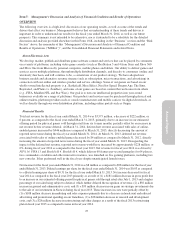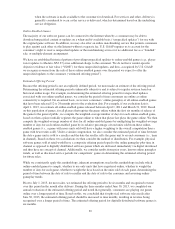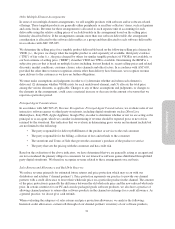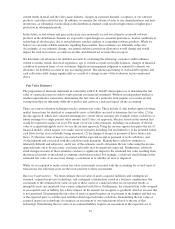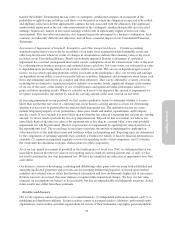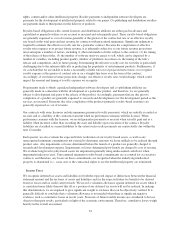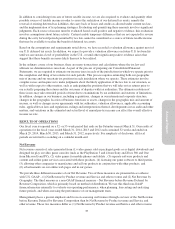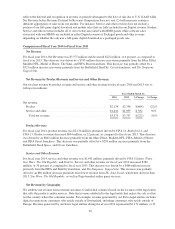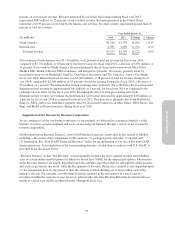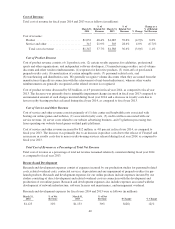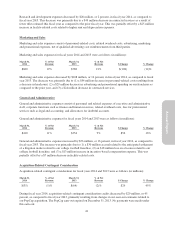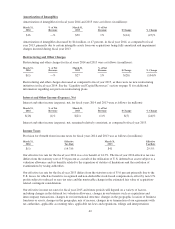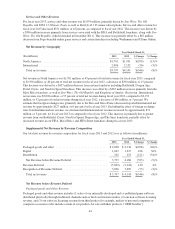Electronic Arts 2014 Annual Report Download - page 105
Download and view the complete annual report
Please find page 105 of the 2014 Electronic Arts annual report below. You can navigate through the pages in the report by either clicking on the pages listed below, or by using the keyword search tool below to find specific information within the annual report.
Annual Report
In addition to considering forecasts of future taxable income, we are also required to evaluate and quantify other
possible sources of taxable income in order to assess the realization of our deferred tax assets, namely the
reversal of existing deferred tax liabilities, the carry back of losses and credits as allowed under current tax law,
and the implementation of tax planning strategies. Evaluating and quantifying these amounts involves significant
judgments. Each source of income must be evaluated based on all positive and negative evidence; this evaluation
involves assumptions about future activity. Certain taxable temporary differences that are not expected to reverse
during the carry forward periods permitted by tax law cannot be considered as a source of future taxable income
that may be available to realize the benefit of deferred tax assets.
Based on the assumptions and requirements noted above, we have recorded a valuation allowance against most of
our U.S. deferred tax assets. In addition, we expect to provide a valuation allowance on future U.S. tax benefits
until we can sustain a level of profitability in the U.S., or until other significant positive evidence arises that
suggest that these benefits are more likely than not to be realized.
In the ordinary course of our business, there are many transactions and calculations where the tax law and
ultimate tax determination is uncertain. As part of the process of preparing our Consolidated Financial
Statements, we are required to estimate our income taxes in each of the jurisdictions in which we operate prior to
the completion and filing of tax returns for such periods. This process requires estimating both our geographic
mix of income and our uncertain tax positions in each jurisdiction where we operate. These estimates involve
complex issues and require us to make judgments about the likely application of the tax law to our situation, as
well as with respect to other matters, such as anticipating the positions that we will take on tax returns prior to
our actually preparing the returns and the outcomes of disputes with tax authorities. The ultimate resolution of
these issues may take extended periods of time due to examinations by tax authorities and statutes of limitations.
In addition, changes in our business, including acquisitions, changes in our international corporate structure,
changes in the geographic location of business functions or assets, changes in the geographic mix and amount of
income, as well as changes in our agreements with tax authorities, valuation allowances, applicable accounting
rules, applicable tax laws and regulations, rulings and interpretations thereof, developments in tax audit and other
matters, and variations in the estimated and actual level of annual pre-tax income can affect the overall effective
income tax rate.
RESULTS OF OPERATIONS
Our fiscal year is reported on a 52- or 53-week period that ends on the Saturday nearest March 31. Our results of
operations for the fiscal years ended March 31, 2014, 2013 and 2012 each contained 52 weeks and ended on
March 29, 2014, March 30, 2013, and March 31, 2012, respectively. For simplicity of disclosure, all fiscal
periods are referred to as ending on a calendar month-end.
Net Revenue
Net revenue consists of sales generated from (1) video games sold as packaged goods or as digital downloads and
designed for play on video game consoles (such as the PlayStation 3 and 4 from Sony and Xbox 360 and One
from Microsoft) and PCs, (2) video games for mobile phones and tablets , (3) separate software products and
content and online game services associated with these products, (4) licensing our game software to third parties,
(5) allowing other companies to manufacture and sell our products in conjunction with other products, and
(6) advertisements on our online web pages and in our games.
We provide three different measures of our Net Revenue. Two of these measures are presented in accordance
with U.S. GAAP – (1) Net Revenue by Product revenue and Service and other revenue and (2) Net Revenue by
Geography. The third measure is a non-GAAP financial measure – Net Revenue before Revenue Deferral by
Revenue Composition, which is primarily based on method of distribution. We use this third non-GAAP
financial measure internally to evaluate our operating performance, when planning, forecasting and analyzing
future periods, and when assessing the performance of our management team.
Management places a greater emphasis and focus on assessing our business through a review of the Net Revenue
before Revenue Deferral by Revenue Composition than by Net Revenue by Product revenue and Service and
other revenue. These two measures differ as (1) Net Revenue by Product revenue and Service and other revenue
35




